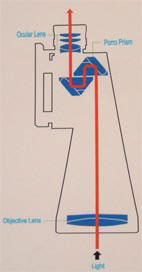|
Giant
binoculars
100mm
giant binoculars
45-degree
BT100 on fork mount
45-degree
BT80
20x90
giant binoculars
20x80
triplet binoculars
20x80
light weight
70mm
giant binoculars
60mm
giant binoculars
56mm
giant binoculars
Marine
binoculars
HG
binoculars
MS
binoculars
Waterproof
binoculars
50mm
binoculars
Zoom
binoculars
Compact
binoculars
Golf
scope/monocular
|
กก
|
Optical coating
information
We've found there is a lot of
mis-information about the coatings of the binoculars made in China. Since different coating configurations lead to very different prices, we feel the need to make some explanation on the coatings.
Firstly, we should know that a side of binoculars includes at least 8 lens: two lens for the objective, two prisms and 4 lens for eyepiece. Some lens (elements) are cemented together. For one element lens, it's a singlet; for two
elements cemented together, it's a doublet; for three elements cemented together, it's a triplet.
As seen on the pic., for a side of a typical binoculars, there are a doublet objective, two prisms, and three lens for the eyepiece: two singlets and one doublet. The surfaces to be coated are the ones that the light transmit through. As seen on the
pic., for one side of the binoculars, the glass-to-air light-transmitting surfaces are: 2 surfaces for the objectives, two long sides of the two prisms, 6 surfaces for the eyepiece, totally 10 surfaces per side. so, a typical binoculars has 20 glass-to-air surfaces to be coated. three lens for the eyepiece: two singlets and one doublet. The surfaces to be coated are the ones that the light transmit through. As seen on the
pic., for one side of the binoculars, the glass-to-air light-transmitting surfaces are: 2 surfaces for the objectives, two long sides of the two prisms, 6 surfaces for the eyepiece, totally 10 surfaces per side. so, a typical binoculars has 20 glass-to-air surfaces to be coated.
Then, below are the coating options you can choose from.
Option I: Magnesium Fluoride coating on 16 glass-to-air surfaces: 4 for two objectives, 12 (6 per side) for 6 eyepieces (3 per side). The four long sides of the four prisms are not coated - it costs more to coat a prism than an objective or an eyepiece. The coating is only one layer usually in blue color. These binoculars are usually marketed as "fully coated" in the international markets.
Option II: Broadband multi-coatings (5-7 layers usually in green color) on the 4 glass-to-air surfaces of the two objectives, and 4 surfaces of the two outmost (ocular) eyepieces (one per side). Magnesium Fluoride coating on the other surfaces: 4 long sides of the 4 prisms and 8 glass-to-air surfaces of the 4 eyepieces (the lens in-between the outmost eyepieces and the prisms). To sum up, broadband multi-coatings on 8 surfaces, one layer Magnesium Fluoride coating on 12 surfaces. These binoculars are usually markets as "multi-coated" in the international markets.
Option III: Broadband multi-coatings on all the surfaces except 4 long sides of the 4 prisms one which there are still Magnesium Fluoride coatings. It costs MUCH more to put broadband multi-coatings on a long side of the prism than on an objective or eyepiece. These binoculars are markets as "fully multi-coated" in the international markets.
Option IV: Broadband multi-coatings on all the surfaces including 4 long sides of the 4 prisms. This is the ultimate coating solution which costs at least 15 times more than the option I, 5 times more than the option II, 50% more than the option III.
Most of the dealers carry the Chinese binoculars with Option I, a few carry the ones with Option II and III, few carry the ones with Option IV.
Actually, to most of the users, binoculars coated as Option I is already good enough in daylight. But, to some critical users like amateur astronomers, binoculars with Option II, III or even IV is
apparently preferred. And, you will also have to make the decision based on whether your
targeted market is very quality-demanding or price-sensitive. The prism is alike: Bak4 prism costs more than Bk7 prism - Bk7 prism is fine to most of the users, but, to some "picky" users, Bak4 prism is a must.
กก
|
